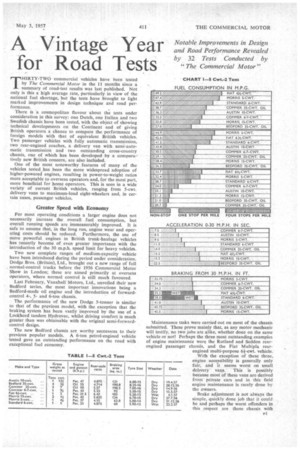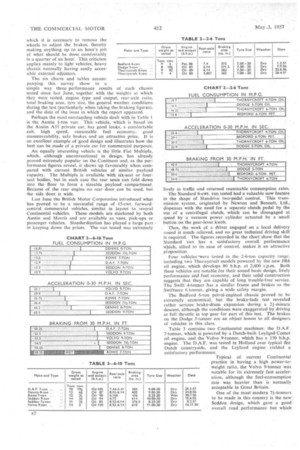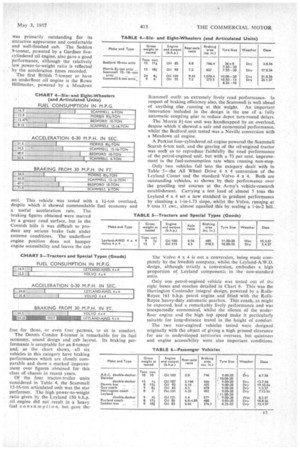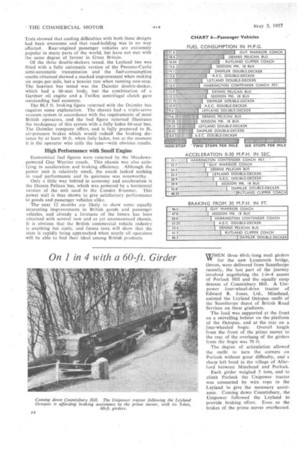A Vintage Year for Road Tests
Page 91

Page 92

Page 93

Page 94

If you've noticed an error in this article please click here to report it so we can fix it.
Notable Improvements in Design and Road Performance Revealed by 32 Tests Conducted by "The Commercial Motor" THIRTY-TWO commercial vehicles have been tested by The Commercial Motor in the II months since a summary of road-test results was last published. Not only is this a high average rate, particularly in view of the national fuel shortage, but the tests have brought to light marked improvements in design technique and road per
formance. ,.
There is a cosmopolitan flavour about the tests under consideration in this survey: one Dutch, one Italian and two Swedish chassis have been tested, with the object of showing technical developments on the Continent and of giving British operators a chance to compare the performance of foreign models with that of equivalent British vehicles. Two passenger vehicles with fully automatic transmission, two rear-engined coaches, a delivery van with semi-automatic transmission and two outstanding cross-country chassis, one of which has been developed by a compara.lively new British concern, are also included.
One of the most noteworthy features of many of the vehicles tested has been the more widespread adoption of higher-powered engines, resulting in power-to-weight ratios more acceptable to overseas operators and, for the most part, more beneficial for home operators. This is seen in a wide variety of current British vehicles, ranging from 5-cwt. delivery vans to maximum-load eight-wheelers and, in certain cases, passenger vehicles.
Greater Speed with Economy
For most operating conditions a larger engine does not necessarily increase the overall fuel consumption, but overall running speeds are immeasurably improved. It is safe to assume that, in the long run, engine wear and operating costs should be reduced. Furthermore, the use of more powerful engines in British trunk-haulage vehicles has recently become of even greater importance with the introduction of the 30 m.p.h, speed limit for heavy vehicles.
Two new complete ranges of medium-capacity vehicle have been introduced during the period under consideration. Dodge Bros. (Britain), Ltd., brought out a new range of full , normal-control trucks before the 1956 Commercial Motor Show in London; these are aimed primarily at overseas operators, where normal control is still much favoured.
Last February, Vauxhall.Motors, Ltd., unveiled their new Bedford series, the most important innovations being a Bedford-made oil engine and the introduction of forwardcontrol 4-, 5and 6-ton chassis.
The performance of the new Dodge 5-tonner is similar to that of the previous model, with the exception that the braking system has been vastly improved by the use of a Lockheed tandem Hydrovac, whilst driving comfort is much greater than was obtainable with the original semi-forwardcontrol design.
The new Bedford chassis are worthy successops to their previous popular models. A 6-ton petrol-engined vehicle tested gave an outstanding performance on the road with exceptional fuel economy. Maintenance tasks were carried out on most of the chassis submitted. These prove mainly that, as any motor mechanic will testify, no two jobs are alike, whether done on the same vehicle or not Perhaps the three most outstanding examples of engine maintenance were the Rutland and Seddon rearengined passenger chassis, and the Fiat Multipla rearengined multi-purpose 6f-cwt. vehicle.
With the exception of these three, engine accessibility is generally only fair, and it seems worst on small delivery vans. This is possibly because most of these vans are derived from private cars and in this field engine maintenance is rarely done by the owners.
Brake adjustment is not always the simple, quickly done job that it could be and perhaps the worst offenders in this respect are those chassis with which it is necessary to remove the wheels to adjust the brakes, thereby making anything up to an hour's job of what should be done comfortably in a quarter of an hour. This criticism
applies mainly to light vehicles, heavy Bedford 6-ton
chassis normally having easily acces
sible external adjusters. Thornycroft 4-ton
The six charts and tables accom panying this survey show in a simple way three performance results of each chassis tested since last June, together with the weights at which they were tested, engine type and output, rear axle ratio, total braking area, tyre size, the general weather conditions during the test (particularly when taking the braking figures), and the date of the issue in which the report appeared.
Perhaps the most outstanding vehicle dealt with in Table I is the Austin +-ton van. This vehicle, which is based on the Austin A55 private car, has good looks, a comfortable cab, high speed. reasonable fuel economy, good manceuvrability, safe brakes and an attractive price. It is an excellent example of good design and illustrates how the best can be made of a private car for commercial purposes.
An equally interesting vehicle is the little Fiat Multipla, which, although unconventional in design, has already proved extremely popular on the Continent and, as the performance figures reveal, it shows up favourably when compared with current British vehicles of similar payload capacity. The Multipla is available with Six-seat or fourseat bodies, but in each case the rear seats can fold down into the floor to form a sizeable payload compartment. Because of the rear engine no rear door can be used, hut the side door is wide,
Last June the British Motor Corporation introduced what has proved to be a successful range of 15.-cwt. forwardcontrol commercial vehicles, similar in layout to <,everal Continental vehicles. These models are marketed by both Austin and Morris and are available as vans, pick-ups or passenger vehicles. Standardization has played a large part in keeping down the prices. The van tested was extremely
I'vely in traffic and returned reasonable consumption rates.
The Standard 6-cwt. van tested had a valuable new feature in the shape of Standrive two-pedal control. This transmission system, originated by Newton and Bennett, Ltd., dispenses with the need for a separate -clutch pedal by the use of a centrifugal clutch, which can be disengaged at speed by a vacuum power cylinder actuated by a small button on the gear-lever knob.
Thus, the work of a driver engaged on a local delivery round is much relieved, and no great technical driving skill is required. The figures recorded in the chart show that the Standard van has a satisfactory overall performance which, allied to its ease of control, makes it an attractive proposition.
Four vehicles-were tested in the 2-6-ton capacity range, including two Thornycroft models powered by the new JR6 oil engine, which develops 80 b.h.p. at 2,600 r.p.m. Both these vehicles are notable for their sound basic design, likely performance and fuel economy, and their solid construction suggests that they are capable of long trouble-free service. The Swift 4-tonner has a similar frame and brakes as the Swiftsure 6-tonner, giving a wide safety margin.
The Bedford 6-ton petrol-engined chassis proved to be extremely economical, but the brake-fade test revealed rather serious brake-drum expansion during a 2}-minute descent, although the conditions were exaggerated by driving at full throttle in top gear for part of this test. The brakes on the Dodge 5-tonner are an object lesson to all designers of vehicles in this class.
. Table 3 contains two Continental machines: the D.A.F. 7-tormer, Which is powered by a Dutch-built Leylvd Comet oil engine, and the Volvo 9-tonner, which has a 150 b.h.p. engine. The D.A.F. was tested in Holland over typical flat Dutch countryside, and the Leyland engine yielded a satisfactory performance.
Typical of current Continental practice in having a high power-toweight ratio, the Volvo 9-tonner was notable for its extremely fast acceleration, although the fuel-consumption rate was heavier than is normally acceptable in Great Britain.
One of the most modern 71-tonners to be made in this country is the new Seddon design, which gave •a good overall road performance but which was primarily outstanding for its attractive appearance and comfortable and well-finished cab. The Seddon 9-tormer, powered by a Gardner fivecylindered oil engine, also gave a good performance, although the relatively low power-to-weight ratio is reflected by the acceleration times recorded.
The first British 7-tonncr to have an underfloor oil engine is the Rowe Hil'master, powered by a Meadows unit. This vehicle was tested with a 11-ton overload, despite which it showed commendable fuel economy and a useful acceleration rate. The braking figures obtained were marred by a greasy road surface, but in the Cornish hills it was difficult to produce any serious brake fade under extreme conditions. The underfloor engine position does not hamper engine accessibility and leaves the cab free for three, or even four persons, to sit in comfort.
Of the four tractor-trailer units considered in Table 4, the Scammell 15-16-ton articulated unit was the star performer. The high power-to-weight ratio given by the Leyland 150 b.h.p. oil engine did not result in a heavy fuel cons it mptio n, but gave the Scammell outfit an extremely lively road performance. In respect of braking efficiency also, the Scammell is well ahead of anything else running at this weight. An important innovation included in the design is the use of a fully automatic coupling gear to reduce depot turn-round delays.
The Morris 81-ton unit was handicapped by an overload, despite which it showed a safe and economical performance, whilst the Bedford unit tested was a Neville conversion with a Meadows oil engine.
A Perkins four-cylindered oil engine powered the Scammell Scarab 6-ton unit, and the gearing of the oil-engined tractor was such as to reproduce faithfully the road performance of the petrol-engined unit, but with a 73 per cent. improvement in the fuel-consumption rate when running non-stop.
Only two vehicles fall into the category dealt with in Table 5-the All Wheel Drive 4 x 4 conversion of the Leyland Comet and the standard Volvo 4 x 4. Both are outstanding vehicles, as shown by their performance over the gruelling test courses at the Army's vehicle-research establishment. Carrying a test load of almost 5 tons the Leyland 4 x 4 set a new standard in gradient performance by climbing a 1-in-1.73 slope, whilst the Volvo, running at 9 tons 11 cwt., almost equalled this by scaling a 1-in-2 hill., The Volvo 4 x 4 is not a conversion, being made completely by the Swedish company, whilst the Leyland-A.W.D. design, although strictly a conversion, embodies a high proportion of Leyland components in the non-standard units.
Only one petrol-engined vehicle was tested out of the eight buses and coaches detailed in Chart 6. This was the Harrington Contender integral design, powered by a RollsRoyce, 161 b.h.p. petrol engine, and fitted with the RollsRoyce heavy-duty automatic gearbox. This coach, as might be expected, had a remarkably lively performance and was unexpectedly economical, whilst the silence of the underfloor engine and the high top speed make it particularly suitable for long-distance travel in the height of comfort.
The two rear-engined vehicles tested were designed originally with the object of giving a high ground clearance for use in undeveloped territories overseas, but quietness and engine accessibility were also important conditions.. Tests showed that cooling difficulties with both these designs had been overcome and that road-holding was in no way affected. Rear-engined passenger vehicles are extremely popular in many parts of the world, but have not met with the same degree of favour in Great liritain.
Of the three double-deckers tested, the Leyland bus was fitted with a fully automatic version of the Pneumo-Cyclic semi-automatic transmission and the fuel-consumption results obtained showed a marked improvement when making six stops per mile, but a heavier rate when running non-stop. The heaviest bus tested was the Daimler double-decker, which had a 66-seat body, but the combination of a Gardner oil engine and a Twiflex centrifugal clutch gave outstanding fuel economy.
The 86.5 ft. braking figure returned with the Daimler bus requires some explanation. The chassis had a triple-servo vacuum system in accordance with the requirements of most British operators, and the bad figure returned illustrates the inadequacy of this system with a fully laden 66-seat bus. The Daimler company offers, and is fully prepared to fit, air-pressure brakes which would reduce the braking distance by at least 30 ft. when fully laden, but at the moment it is the operator who calls the tune—with obvious results.
High Performance with Small Engine
Economical fuel figures were returned by the Meadowspowered Guy Warrior coach. This chassis was also satisfying in acceleration and braking efficiency. Although the power unit is relatively small, the coach lacked nothing in road performance and its quietness was noteworthy.
Only a little way behind in economy and acceleration is the Dennis Pelican bus, which was powered by a horizontal version of the unit used in the Condor 8-tonner. This power unit is thus shown to give satisfactory performance to goods and passenger vehicles alike.
The next 12 months are likely to show some equally interesting improvements in British goods and passenger vehicles, and already a foretaste of the future has been obtained with several new and as yet unannounced chassis. It is obvious that the British commercial vehicle industry is anything but static, and future tests will show that the state is rapidly being approached when nearly all operators will be able to find their ideal among British products.












































































































































































































































